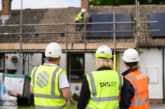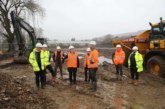Michael Gove’s reply of ‘30,000-a-year at least’ when asked for a figure by ITV’s Daniel Hewitt as to the number of social rented homes he wants to see built, put down a marker which is welcomed. Here, John Bowker, Chair of JV North and Executive Director of Operations at Stockport Homes Group, highlights why there needs to be a greater focus on more social housing to tackle the housing crisis.
What the sector needs next are details on how these homes are going to be funded.
The Housing Secretary also added in the interview that he has renegotiated money in the 2021/26 Affordable Homes Programme so more will be spent explicitly on social rented properties.
To help us plan and build, we now need specific figures in terms of the overall amount of funding assigned and a breakdown as to how this will finance 30,000 homes over each of the three remaining years of the current Affordable Homes Programme.
What better way of demonstrating to the public (and housebuilding landlords) that all parties see fixing the housing crisis as vitally important, than by committing to ringfencing this money and retaining it if there is a change of administration at the next general election.
In order for a minimum of 30,000-a-year to be built — and we should also bear in mind Shelter’s research says three times that number are needed — political unification is vital.
To start we need not only the Government to agree its housing strategy internally, but then to achieve cross-party support acknowledging more social rented homes are required and work to a collective plan.
This must have substance with long-term policy and financial commitment so we can deliver consistently over the coming decades. This is crucial because the nation’s housing crisis is too big to fix in one or two Parliamentary terms.
For perspective, just 7,644 social rented homes were built last year so a significant increase is being targeted especially when nearly 25,000 properties were sold off in 2022 under Right to Buy and a further 3,000 were demolished. These figures are well documented and acknowledged by government as needing to be changed.
The importance of social rent can’t be underestimated because in a cost-of-living crisis homeownership is unrealistic and out of reach for so many, while huge numbers can’t afford their rent. Therefore, we would welcome a tailored approach to the Government’s housing offer which best meets the needs of people and reflects the realities of society.
Presently this means more focus and support for social rented homes and greater assistance for housebuilding landlords faced with high inflation, interest rates and supply chain demand.
Working with this end in mind, structuring the next Affordable Homes Programme will also help housing associations adapt and flex their business plans accordingly.
We know there is still a very strong appetite across the sector to deliver more homes of the right type that specific places and communities need with the most appropriate tenures; that is certainly the case with JV North members.
The availability of grant funding three years into the current programme has ensured demand remains strong.
Most of all and by acknowledging the likelihood of a general election in 2024, housebuilding landlords’ main ask is for the earliest possible release of the next programme beyond 2026 to give us the best chance of planning for and achieving the targeted number of new homes.
It is vital we maintain the momentum.
At JV North, members have worked hard with consultants and contractors during the difficult trading times recently to ensure we act as conscientious clients aware of the flexibilities that need to be displayed to ensure continuity of delivery.
We are ready to deliver more.
While many may point to the Government’s social rented home figures as being highly ambitious especially when coming from today’s low starting base, the sector has the appetite and proven track record to deliver when given the right support.
We now just need the clarity and long-term financial backing to make it happen.










